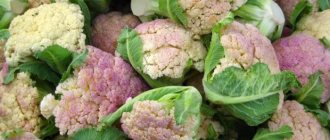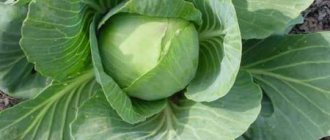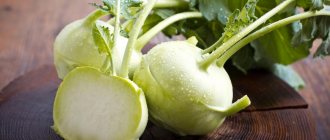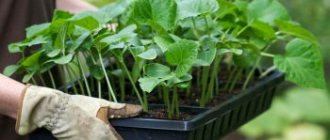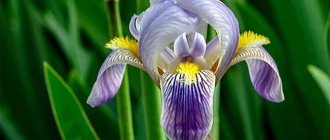Botanical description
Cauliflower is an annual plant. The seeds are black and brown, similar to the seeds of white cabbage, only small. The cotyledons have a shape very similar to the cotyledons of white cabbage, only slightly longer and purple in color at the bottom with anthocyanin. The leaves are long, sessile (only the first leaves have rather long petioles).
The root system is fibrous, weaker than that of white cabbage. The plant first creates a rosette of leaves on a short stem. 75-80 days after germination, the growth of the stem stops and a head is formed at its end, that is, a shortened shoot with an inflorescence in which the plant accumulates a supply of substances. If the head is not cut, after a few days it becomes loose, acquires a greenish-purple color, later green and is divided into separate shoots, which after 4-5 weeks reach a length of 60-70 cm and resemble the stems of other cabbages.
The so-called fork or head of cabbage is the edible part of the plant. It is usually white in color, although it can have other colors. The fork consists of a huge number of florets that are fleshy and compact, making them great for cooking.
The plant has yellow or pale green flowers.
Timing for picking seedlings
Young plants begin to be planted after three true leaves appear on the seedlings. Root the plants so that the roots and stem are completely covered with soil. With the appearance of the third leaf, the seedlings are fed with ammonium and potassium nitrate. The optimal picking time is 10-14 days after germination.
The most favorable days for picking cabbage according to the lunar calendar are:
- January 6, 7-8, 29;
- February 1, 3, 4, 5, 6, 24-25, 27, 28;
- March 3-5, 17, 27-28, 29-30;
- April 1-2, 7, 24, 28.
The growth and development of plants is strongly influenced by the moon. The earth's satellite detects and regulates the movement of sap in the stems, leaves and roots of plants. It is recommended to start picking seedlings on the waxing moon (at this time the movement of sap is directed upward, from the roots to the stems, the above-ground part of the crop develops better) or at the beginning of the waning moon (liquid actively moves from the stems to the roots; seedlings take root more easily and quickly).
Unfavorable days for picking cauliflower seedlings are April 15-17.
Energy and biological value
The chemical composition of the head of this cabbage is similar to the chemical composition of the head of white cabbage, the difference is that it contains a little more protein and minerals, and less fiber. Consequently, this cabbage has a milder taste and is easier to digest. The heads contain more vitamin C than the cabbage heads. In addition, it contains vitamins K, B6, B9, a little manganese, potassium, and a little less iron and magnesium.
This is a very low-calorie vegetable. 100 grams contain about 20 kcal, so one medium-sized fork contains about 200 kcal.
Nutritional value
| 100 g of product contains, g | |
| carbohydrates | 5 |
| squirrels | 2,5 |
| cellulose | 2,4 |
| fat | 0,2 |
Climatic requirements
The crop is resistant to cold, but prolonged cold causes premature development of small inflorescences.
Other reasons for the formation of small forks:
- damage to the root system during transplantation,
- lack of water in the soil,
- lack of nitrogen,
- pest damage.
At high temperatures, the forks “disintegrate.” Drought combined with high temperature causes the formation of small inflorescences, loose and quickly turning yellow.
Cabbage creates the most beautiful forks under the following conditions:
- temperature 14-18 °C,
- relatively high humidity,
- short days - in spring and autumn.
Cabbage seedlings are sensitive to shade and “stretch out” very quickly, but adult plants tolerate shade well. You should also avoid places that are too windy, which negatively affects the size of the crop.
What temperature can cabbage seedlings withstand? Cabbage and frost
In various regions, the period of possible cooling may last until mid-June.
Whether cabbage seedlings are afraid of frost, what kind of frost cabbage can withstand in the spring, and how low temperatures can affect the quality of the crop depends on what type and variety was chosen for cultivation.
Temperature limits for use
Plant seedlings with the seedless growing method die at -3°C. If the seedlings were grown in cold greenhouses or were pre-hardened before planting in the garden, then they can withstand a short-term decrease in temperature to -5°C, but in this case the total weight and quality of the finished heads of cabbage decreases. If the temperature outside drops below -5°C, the seedlings die.
Reasons for freezing cabbage
Let's consider the reasons for the death of cabbage during frosts. Both frost and heat are harmful to the development and life of cabbage seedlings in spring.
If the air temperature drops below 0°C, the water in the plant cells freezes and turns into ice. From the physics course we know that if water is frozen, then when it freezes it increases in volume. The same thing happens in plants. When frozen, the liquid ruptures the seedling cells from the inside, and the cabbage dies. Sudden thawing after sunrise is especially dangerous for plants.
You can't let it thaw
The influence of low temperature can aggravate the wrong choice of planting site, as well as the condition of the seedlings.
Risk areas for cabbage
Do not plant plants on heavy soils or in lowlands. Light loamy areas well protected from the wind are suitable for it. In addition to the fact that there is constant stagnation of moisture in the lowlands, the air during frosts is also 2-3°C lower than in the flat areas.
For optimal plant development, the soil should not be acidic. On such soils, cabbage will not be able to develop normally, it will get sick, and the fertilizers that you apply will not be able to be completely absorbed by the seedlings. Therefore, if the soil on the site is acidic, then it needs to be limed. Dolomite flour is perfect for these purposes, as it will additionally enrich the earth with potassium. If flour is not available, you can use chalk, ash or lime. Only lime can be used exclusively during autumn digging, so as not to damage the seedlings.
If the acidity level is increased, then the soil is treated with lime
Whether cabbage is afraid of spring frosts, and how affected the seedlings will be, also depends on the general condition of the plants. If they are healthy, have managed to strengthen and grow well, then the seedlings will recover from stress much faster and the damage to the crop will be minimal.
To grow healthy seedlings, you need to maintain temperature conditions. The optimal range is 12-20°C. Higher temperatures lead to seedlings beginning to lag behind in development, becoming weak and not as viable.
It is also necessary to monitor the water regime. Cabbage is a moisture-loving plant, but watering should be such that there is no stagnation of water in the holes. Excess water, as well as its lack, can lead to disease or death of plants.
Note! The tolerance of low temperatures by seedlings also depends on the type of cabbage.
Soil requirements
The culture has a weak fibrous root system, therefore it is the most demanding of all types of cabbage regarding soil. To grow it, you need soil with the following characteristics:
- permeable,
- quite wet,
- rich in nutrients.
This cabbage loves the following soils:
- black soil,
- loess,
- nutrient-rich soils.
Depending on the variety, you need to choose the soil:
- for early varieties and accelerated harvesting, you should choose areas with lighter soils;
- for later varieties - heavier soils.
The vegetable grows poorly in acidic and alkaline soils and creates small forks; the plant is prone to disease. Optimal pH 6.5-7.5.
In regions where there is a lack of rainfall during the head setting period, the plants should be irrigated, preferably by sprinkler irrigation.
Optimally, 1 dm³ of soil should contain:
| Battery, mg | Ripening period | |
| growing early harvest | growing mid and late cabbage | |
| N (NO2 + NH4) | 105-120 | 120-135 |
| P | 50-60 | 60-70 |
| K | 160-190 | 190-220 |
| Mg | 45-60 | 60-75 |
| Ca | 1000-1500 | 1000-1500 |
Description of culture, its features and properties
Cauliflower is an annual garden crop grown throughout the world. Its roots are fibrous, the leaves are oblong, pinnate or lanceolate (depending on the species), the stem is smooth and dense, the fruits are round or flattened heads, consisting of inflorescences.
It is these fleshy inflorescences that are used for food, which, depending on the variety, are colored white, cream, orange, green or purple. Cabbage pulp is rich in vitamins and minerals, and their content exceeds that of other cabbage vegetables, for which nutritionists respect it so much.
Despite the low calorie content (only 30–35 kcal per 100 g of product), with one serving you can get a daily dose of all the necessary micro- and macroelements. Cauliflower contains a full range of vitamins - A, C, B, E, D, U, K, H, PP; and minerals - calcium, potassium, phosphorus, magnesium, manganese, iron, zinc, copper, sulfur, sodium.
Not to mention other components:
- Cellulose.
- Fast digestible proteins.
- Organic acids (citric, malic, tartronic).
- Amino acids.
- Pectin.
- Starch.
- Sugars and carbohydrates.
- Biotin (a rare substance that strengthens nerves).
All components have a beneficial effect on the functioning of the entire body as a whole and on individual systems: digestive, nervous, cardiovascular, immune. The tender pulp, as if melting in the mouth, does not irritate the mucous membrane of the stomach and intestines, and is approved for use by babies during the first feeding period. Cabbage has virtually no contraindications or restrictions; it is the leader in the world vegetable market and is second only to the white cabbage variety.
Initially, the culture was recommended for use as a medicine and to strengthen the body in winter, but breeders removed the natural bitterness from the pulp and created an ideal dietary product. Benefits for the liver have been proven; the vegetable has a choleretic effect, removes toxins and heavy metals, cleanses the blood, reduces cholesterol production, and strengthens the immune system.
Important! The only case in which it is worth limiting the consumption of vegetables is gout.
Growing and care
This crop is grown for early or late harvest. The heads of early varieties reach the required size almost a week earlier than the heads of mid-ripening cabbage sown on the same date.
Fertilizers and fertilizers
This cabbage is one of the vegetables with the greatest need for fertilizers. When growing it, the timely supply of nutrients (nitrogen, phosphorus, potassium) during the period from planting to setting the heads is important.
In the fall, rotted manure is applied to the area intended for cabbage and the soil is dug deep.
Dose of manure
| Soil type | Application rate, kg per hundred square meters |
| fertile humus | 300 |
| weaker | 600 |
Acidic soil needs to be limed. The nutrient content of the soil should be the same as for early white cabbage, but cauliflower has higher phosphorus requirements (about 30% more).
Fertilizer application rates in spring
| Battery | Application rate per 1 hundred square meters |
| Phosphorus | 900-1100 g P205 (5-6 kg superphosphate) |
| Potassium | 1500-1900 g K20 (3 kg potassium salt 50%) |
| Nitrogen | 1200-1800 g of nitrogen in the form of calcium nitrate, urea or nitrate |
Excess nitrogen can cause plants to grow too much and delay flower formation. Nitrogen deficiency is very dangerous because it causes poor plant growth and the formation of miniature heads. Nitrogen fertilizers are applied in 3 doses:
- ½ dose - before planting;
- ¼ - 2 weeks after planting the seedlings;
- ¼ -in 2-3 weeks.
It is important to properly fertilize the beds with boron and molybdenum, because a lack of boron causes darkening of the forks, and a lack of molybdenum causes slower growth of leaves.
Attention! It is necessary to carefully select fertilizers, especially chloride ones - cabbage, especially cauliflower, reacts poorly to high chlorine content.
We recommend foliar feeding, for example, with Florovit, or fertilizing the beds with borated superphosphate.
Growing seedlings
The sowing date for early varieties depends on the expected harvest date.
| Date of sowing seeds of early varieties for seedlings | Harvest date |
| end of January | horses May - early June |
| mid February | mid June |
| March | July |
To plant 1 acre you need 3 g of seeds.
Cabbage seeds are sown in boxes, and after germination they are planted in pots with a diameter of 5-6 cm. Cauliflower seedlings are grown at home at a temperature of about 13-15 degrees until a suitable plant size is obtained, which will take about 2 months.
Growing seedlings includes a number of care activities. The room temperature should be maintained at 15-16 °C on sunny days and 12 °C at night and on cloudy days. Cauliflower has a weaker root system than white cabbage, so plants planted in peat pots are much better accepted and produce a harvest earlier; the heads produce more attractively than from pickled seedlings grown in seedling boxes.
A few days before planting in the ground, seedlings should be hardened off. A good seedling is squat, healthy, 10-16 cm high.
Landing
After hardening off the seedlings and spraying them against cabbage flies and gall midges, they are planted in open ground. The earliest varieties are planted in open ground from April 10 to April 25 with a spacing of 50 × 40 cm. The spacing for later varieties is 50 × 50 cm, for later varieties - 80 × 50 cm and even 60 × 60 cm on very fertile soils.
When the seedlings have begun to grow, they are fed with ammonium nitrate (900-1300 g per hundred square meters), the same dose is applied after 2-3 weeks.
Watering, weed removal
The most important factor determining success in growing this vegetable is proper irrigation. The plant has the greatest need for water during the period of growth of 6-7 leaves and tying forks. Good results are achieved by irrigating the plantation twice. The optimal soil moisture should be 75-80%. Excess water provokes the formation of small and bluish heads.
Basic agricultural operations also include weeding plantations and loosening the soil.
Why does cauliflower turn yellow and what to do?
When exposed to sun and rain, cabbage forks lose their white color and turn yellow. To prevent this from happening, they are covered by folding 3 inner sheets over the head or tying them together.
For this purpose, you can use colored rubber bands, using a different color rubber band every day. After 3-5 days, the forks grow, and by the color of the rubber bands it is easy to figure out which cabbage is suitable for harvesting.
Diseases and pests
The main threats in cultivation are the following diseases:
- black leg of cabbage,
- black mold,
- wet rot,
- kilo of cabbage,
- Alternaria blight.
The following pests can harm the crop:
- spring cabbage fly,
- weevils,
- scoop-gamma,
- cabbage butterfly,
- cabbage aphid,
- cabbage scoop,
- cabbage moth.
Varieties and hybrids of cauliflower
Breeders have created a large number of varieties and hybrids of cauliflower. Different types and varieties are suitable for preparing different dishes. This is one of the important criteria when choosing a variety to plant on your site.
Modern varieties of cauliflower produce good yields in different climatic conditions. It is necessary to correctly assess the possibilities of growing a variety in your region.
For proper development, the plant needs the necessary amount of heat.
The climate of the Moscow region and in the southern regions varies greatly. In the northern regions and Siberia, it will be difficult to grow cauliflower in open ground without the use of shelters.
Parameters that you need to pay attention to when choosing a variety:
- Varieties and hybrids are created by breeders for specific growing conditions. Plants are tested and recommended for planting in specific regions. It is necessary to choose a variety for your growing zone;
- When purchasing foreign varieties and hybrids, the manufacturer must indicate recommended temperature conditions during the growing season;
- Different varieties are designed for growing in different types of soil. Here it is worth paying attention to the compliance of the declared parameters of the composition and acidity of the soil in which the plant is supposed to be grown;
- Responsible producers offer hybrids that are resistant to the most common diseases and pests. Taking this parameter into account, it will be possible to reduce the number of sprays with chemicals, and therefore obtain products that are safe for consumption;
- You should choose varieties that are suitable for the size of the head of cabbage and its density. This will allow you to use the entire plant for cooking, without additional unnecessary storage of leftovers in the refrigerator, which entails a decrease in the content of vitamins and nutrients;
- Be sure to pay attention to such a parameter as the length of daylight hours for a particular variety. The further south the planting region, the shorter the daylight hours there in summer;
- When purchasing hybrids, it is worth remembering that the seeds obtained from them are unsuitable for further use. It is impossible to predict the yield of plants grown from seeds obtained from hybrids;
- If unfamiliar varieties are chosen for planting, it would be correct to grow several varieties of cauliflower. In subsequent years, the choice is made in favor of varieties that are most productive and less susceptible to diseases and pests;
- Varieties with different ripening periods will allow you to obtain a harvest throughout the season without interruptions.
Selecting a variety based on all the above features is possible only in specialized stores. There you can often purchase seeds in so-called “semi-professional” packaging. It is made of several layers of paper and metal foil, which prevents excessive drying of the seeds, protects them from sunlight, and extends shelf life. There is a complete description for such seeds, with all important characteristics presented.
An important parameter of varieties and hybrids is their ripening time. There are:
- Early ripening varieties with a ripening period of 80-110 days;
- Early – 115-125 days;
- Mid-season – 126-135;
- Late – 145-170.
Early varieties of cauliflower
Early varieties of cauliflower produce a harvest within 60-100 days.
Snowdrift . Ripening time is 90-100 days. Weight up to 1200 gr. The heads are medium-sized, snow-white in color. Great for freezing.
Amethyst . Growth time is 80 days after planting in the ground. Weight reaches 1 kg. The fruits are smooth, slightly purple in color.
Maliba . Very early variety - 55-65 days before reaching ripeness. The heads are milky white, weighing up to 5 kg.
Medium varieties of cauliflower
The growing period for these varieties is 100-135 days.
Yako . The mass of the hard density head is 850 g. They are grown in a second wave of planting in summer and autumn.
Lilac ball . The variety is frost-resistant. Purple head up to 1.5 kg, stores well.
Asterix F1 . Hybrid resistant to powdery mildew, cold and humid climates. Heads weighing up to 1 kg, white, hidden by covering leaves.
Late varieties of cauliflower
Late varieties of cauliflower are ready for harvesting after 160 days of cultivation.
Autumn giant . It grows in 200-220 days. White dense heads reach a mass of 2.5 kg.
Regent . The variety tolerates frost well in the fall. Small heads from 550 to 800 g.
Amerigo F1 . High yield hybrid. Demanding on soil fertility. The heads are self-covering and reach a weight of up to 3 kg.
Growing Late Harvest
For late harvest, early and mid-early varieties of cabbage are grown. In places where drought sometimes occurs when planting cabbage, it is better to prepare seedlings in pots or in a nursery in open ground. Seeds are sown in boxes in the first half of June, and seedlings are planted in a permanent place in late July - early August.
The most favorable temperature for forming cabbage forks is 14-18 degrees Celsius. The minimum temperature for cultivation is 6-8 degrees Celsius.
The autumn harvest begins at the end of September and continues until October. Late cabbage is usually grown after other plants have been harvested.
The culture requires fertile soils, rich in humus and nutrients, permeable and airy, pH 6.5-7.0. The landing site should be sunny and protected from the wind.
If the soil is not rich enough, immediately after harvesting the previous crop, you should add well-rotted manure or compost in the amount of 400-500 kg per hundred square meters and mineral fertilizers in the same amount as when growing early cabbage.
The distance between plants is 60 × 50 cm or 70 × 60 cm, depending on soil fertility.
Often not all plants form heads before the onset of frost. Plants with heads about 3 cm in diameter can be dug up by the roots and planted in a light basement or greenhouse, watered abundantly without wetting the leaves.
The room temperature should be maintained at 4-5 °C; at higher temperatures the forks will disintegrate. The premises must be ventilated. When the heads grow, all plants are uprooted or cut off near the ground. Inflorescences can be collected from such plants until mid-winter.
Pests and diseases of cauliflower
The climatic conditions of our country contribute to the infection of cauliflower with various diseases. Plants do not tolerate sudden changes in night and day temperatures and increased soil moisture.
Cauliflower diseases
- Alternaria blight - manifests itself in the appearance of black or dark brown spots covering the leaves. The disease develops in humid environmental conditions at temperatures above 30ºC. Seeds are often infected. They need to be treated with antifungal drugs.
- Kila. An external sign is swelling and growths on the roots, which lead to rotting of the roots. Lack of moisture and nutrition destroys the plant. Clubroot remains in the soil for more than 5 years. Planting cauliflower in places where the disease was previously detected will certainly lead to damage to the new crop. Crop rotation is an important measure for disease prevention.
- Ring spot is identified by black spots on the stems and leaves of the plant. Subsequently, the dots grow into concentric circles (hence the name of the disease). Thrives in cool and humid weather. For prevention, the quantity and abundance of watering is strictly regulated. When harvesting predecessors, organic residues are carefully removed.
- Wet rot. Excessive watering leads to the occurrence of disease. Watery spots appear on the heads, and black areas appear on the stems of the plants. The green part begins to rot and turn black. The cause of the disease is wet weather and damage to the green parts of the plant. Prevention - spilling the soil and spraying the cabbage with colloidal sulfur.
- Fusarium - the leaves of the plant become yellow on one or both sides. Dark spots appear, leaves fall off, and the head becomes deformed. Plants are treated with antibacterial drugs.
- Blackleg attacks plant seedlings at high humidity and low temperatures. Affected plants are immediately removed and destroyed. The disease cannot be treated.
- Downy mildew. A whitish coating appears on the lower parts of the leaves, and depressed spots form on the inside of them. The first signs serve as a signal to treat the plant with fungicides.
- Mosaic. 30 days after planting in open ground, the veins of the plants become light in color, and the leaves wrinkle, slowly die, dry out and fall off. The disease is usually spread by sucking insects, carriers of viral diseases.
Cauliflower Pests
All cruciferous plants have similar pests.
- Cruciferous flea beetles are small bugs that eat young shoots and leaves of mature cabbage. Among the “folk” methods of control, planting garlic or tomatoes next to cabbage is popular.
- Eggs laid by the cabbage fly develop in the upper layers of the soil. Penetrating into the root system, they destroy the plant. Prevention consists of watering the soil around the plant with special chemicals. It is useful to plant celery next to the cabbage bed.
- The cabbage aphid is a sucking insect that simultaneously introduces viral diseases into plants. Insecticides are used for control.
- Cabbage whites, cutworms and moths are dangerous because of their caterpillars, which feed on the leaves of the plant. They destroy clutches of eggs or the caterpillars themselves with biological preparations.
As you can see, the requirements for growing cauliflower are not complicated. Any gardener with the least amount of experience can easily get a decent harvest from his plot - tasty, healthy, and shelf-stable for a long time.
Harvesting
During the cool period, the plantation is monitored every 2-3 days, on warm days - daily, ripe forks are cut off, young ones are protected from yellowing.
Harvesting is best done on cloudy days or in the morning (especially on hot days), when the heads are hard, cut them out along with a few surrounding leaves. For sale, the forks are sorted by size and placed in vegetable boxes.
The standard yield of cauliflower per 1 acre is 300-400 kg.
Preparing the bed
To obtain a high-quality harvest of cauliflower, planting and caring for it must begin with the correct choice of site and proper preparation of the future bed. The landing site should be:
- very bright, illuminated by the sun throughout the day without the slightest shading;
- maximally protected from cold winds and dry winds, but well ventilated;
- not used in the previous year for growing any cruciferous crops;
- not too dry, but also without stagnation of water;
- with loamy soil and a large layer of humus.
They begin to prepare the bed in the fall - they dig it up and always add organic fertilizers (humus, manure, compost, etc.). Such feeding is very important for this crop, since the decomposition of biological residues is accompanied by the release of carbon dioxide, which is necessary for the proper formation of the cabbage head. Without this, neither the inflorescences nor the rosette will develop.
Related article:
Growing Brussels sprouts from seedlings
Apply any of the specified fertilizers for digging, using 1 bucket of fresh manure or 3 buckets of compost or humus per 1 square meter. m, fixing it on the bayonet of a shovel. Additionally, it is recommended to add 2 tbsp. superphosphate. For acidic soil, you will also need lime, but it is not combined with the specified organic matter, but is added 60 days earlier or in the spring when planting directly into the hole.
Storage
After harvesting, cabbage must be cooled as quickly as possible to a temperature of 0-1 degrees Celsius. In the refrigerator at this temperature and air humidity of 85-90 percent, the harvest can be stored for up to 2 months; in ordinary warehouses or basements, cabbage forks are stored for no more than a few days. The autumn harvest is stored much better when packed in plastic wrap.
Thanks to the ability to freeze, this cabbage is a vegetable that is available throughout the year.
Beijing cabbage is afraid of frost. Is the vegetable afraid of frost?
When is it better to chop cabbage for the winter: before or after frost? Many varieties of cabbage are frost-resistant, which means they are not afraid of frost. But in order for cabbage to retain its ability to be stored for a long time without losing its freshness, its exposure to low temperatures during its stay in the garden should be short-lived.
Harvesting cabbage from under the snow at temperatures below -6 degrees has a negative effect on all varieties of cabbage, as does repeated frosts after thawing. When thawed, the outer cabbage leaves become home to microscopic organisms that cause rotting of the crop.
Cut heads of cabbage cannot be left outside at sub-zero temperatures; their long-term storage will then be impossible.
What frosts can cabbage withstand in the fall? Cabbage, as a rule, tolerates the first temperature fluctuations below zero without problems.
Light frost even has a positive effect on the taste of this vegetable: a sweetish taste appears.
The maximum sub-zero temperature that cabbage can withstand is minus 6 degrees Celsius, provided that the thermometer does not stay at this mark for a long time.
What frosts can late varieties of cabbage withstand? Late-ripening varieties are also called mature varieties. In order not to deprive them of their “keeping quality” (long shelf life), they should not be exposed to temperatures below 6 degrees Celsius.
And for cut late-ripening heads of cabbage, even -1 will be a great tragedy: on the sections, the tissue of the stalks is exposed and freezes very quickly, which subsequently starts the processes of rotting.
Sauerkraut is usually made from heads of cabbage that have been exposed to temperatures as low as -4 degrees Celsius during their growth.
Is Chinese cabbage afraid of frost? Chinese (Peking) cabbage is frost-resistant, but after freezing below -4 degrees Celsius it begins to rot. It is not recommended to expose Chinese cabbage to temperatures below -2 degrees Celsius. It is collected around October 15, when there are no permanent frosts. You can learn about ways to store Chinese cabbage from our article.
Which cabbage tolerates frost well? Frost-resistant cabbage varieties labeled F1: “Katyusha”, Russian Winter”, “Ulyana”. “Lika”, “Yaroslavna”, “Sugarloaf”, “Ukrainian Autumn”, “Zimovka”, “Amager 611”, “Snow White”, “Violanta” and “Kharkovskaya Zimnyaya” also tolerate frost well.
What to do if cabbage is frozen? The heads of cabbage should thaw without being cut. This usually takes 4 - 5 days, after which the cabbage can be cut and sent for the winter.
Is it possible to harvest cabbage after freezing? Immediately after freezing, cabbage cannot be stored for storage. If you do not wait a few days until the cabbage thaws on the root, it will begin to rot in the first month after harvesting: black leaves will appear.
How to use
This plant has been known for hundreds of years, so there are various uses for it. In the simplest version for consumption, it is enough to boil the cleaned forks in salted water. They taste great breaded and topped with toasted breadcrumbs.
The most popular use of the vegetable:
- soup,
- salads,
- baked,
- fried inflorescences in batter after preliminary boiling,
- risotto,
- casseroles,
- in pickled form.
So, this is a very popular vegetable that can be used in many different ways. A large amount of vitamins and very low calorie content make it popular. The vegetable is easily digestible, which increases its attractiveness. Using culinary varieties with multi-colored forks, you can increase the originality of dishes and their attractiveness for children.
